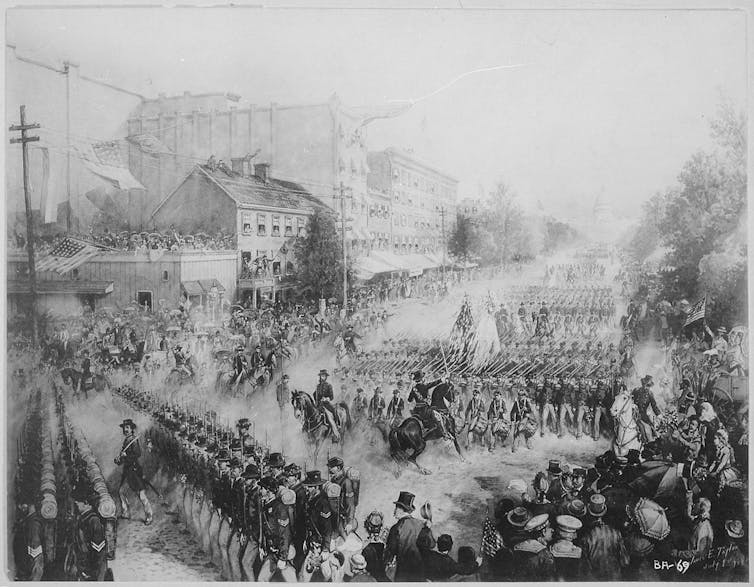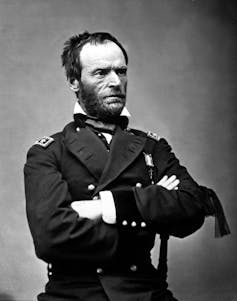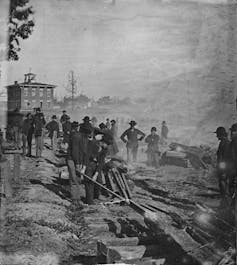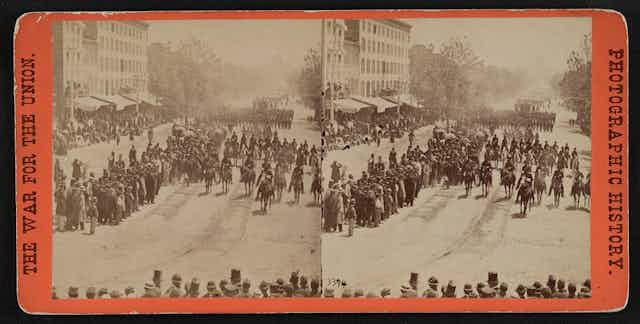They marched down Pennsylvania Avenue, 65,000 strong, tightly packed, in a column that ultimately stretched for 15 miles and took over six hours to pass.
Their “glittering muskets looked like a solid mass of steel, moving with the regularity of a pendulum.”
Sherman’s Army marched steadily, firmly, like the hardened veterans that they were, with dignity and discipline.
They marched through throngs of cheering spectators, thousands upon thousands of black and white Washingtonians, crowding the streets and the sidewalks, leaning out of windows and huzzahing.
Their torn and dirty flags were garlanded with flowers, but black streamers hung from the staffs, emblems of mourning for Abraham Lincoln.
The Army of the Potomac had marched the day before, all spit and polish, to great cheers of acclamation, but this day, May 24 1865, belonged to the Western Army, to Sherman’s Bummers. “Bummer” had once been used as an epithet for slackers and thieves, but Sherman’s men took this on as an honored nickname.
They were, in the words of the New York Times, the “glorious veterans…heroes of the greatest march on record,” and their beloved Uncle Billy, General William Tecumseh Sherman, was the man of the hour.
Parading with the spoils of war
Spectators uniformly noted that the cheers for the Westerners were even louder and more sustained than those for the Easterners.
Nor did they march alone. Sherman’s Army, famous for making Georgia – and then South Carolina and North Carolina – howl, brought their spoils of war to the victory parade.
Each brigade was led by its respective “pioneer corps,” made up of formerly enslaved men who were put to work clearing swamps and building roads, helping the soldiers as they hacked their way across the Confederacy.
And interspersed throughout the columns of soldiers were scenes designed to bring the story of the march right into the heart of the capital: African-American mothers with their children; mules and donkeys laden down with hams and chickens; soldiers’ pet dogs and raccoons.
The crowd responded to these amusing vignettes with further cheers and gales of laughter.
The beginning of remembering
The Grand Review of the Union Armies on May 23-24 1865 was a performance, a victory display of martial power designed to put the final punctuation on the war.
Washingtonians literally swept away the mourning crepe that had draped buildings for the previous five weeks, and greeted the soldiers with open arms and an outpouring of emotion.

Sherman was himself a master of the theatrical grand gesture, as evidenced by the drama of his march, and he embraced this opportunity.
For the Grand Review didn’t just mark the end of the war, but the beginning of the remembering. And Sherman’s soldiers carefully crafted their own narrative of what the march meant to them.
Today, Americans’ cultural memory of Sherman’s March is generally that of the Southern civilians who saw their homes raided and their property destroyed.
It is a memory that has been shaped most profoundly by Gone with the Wind – both the book and film – and the result is a portrayal of Sherman as Attila, and his men as Huns or Vandals, bent on vengeance, careless with fire, possibly guilty of war crimes.
But that’s not how Sherman and his men were seen during the Grand Review, and it’s not how they saw themselves.

Sherman’s veterans, at least those who spoke and wrote publicly about their experiences, were remarkably untroubled by the war they made against civilians.
They looked at the march not as something that broke the laws of war, but instead as one of the great experiences of their lives.
The veterans speak
For Sherman’s veterans, the Georgia and Carolinas campaigns, with their short daily marches, abundant food and lack of fighting, were a lark.
As General Noyes recalled in 1869,
“in this rollicking picnic expedition there was just enough of fighting for variety, enough of hardship to give zest to the repose which followed it, and enough of ludicrous adventure to make its memory a constant source of gratification.”
And their reminiscences were often quite funny, even as they told of stealing clothing or wrecking storehouses. They praised Bummers for their endless appetites.
One veteran called the common soldier “an Octopus of Abdomen, whose tentacles reached every hen roost and pig sty.” They were adventurers and rogues, not despoilers and villains.
But to see Sherman’s veterans as emphasizing only the lighthearted aspects of the march is to fundamentally misunderstand what it meant to them.
For all their minimizing of hardships and the horrors of war, they well understood what they fought for, and they believed wholeheartedly that their march, their efforts, had brought the war to an end.

They never wavered in their belief that the march was necessary. The Confederacy had brought destruction on itself by tearing apart the Union, they believed, and it was the duty of these soldiers to reunite the nation, by any means at their disposal.
Many of Sherman’s veterans sought to preserve their own memories of the war and the march in order to explicitly counter the pro-Confederate Lost Cause that gained prominence during the late 19th century.
Their efforts were no match for that cultural tide. Only now, as the sesquicentennial passes, can we pause to remember their version of Sherman’s March.

